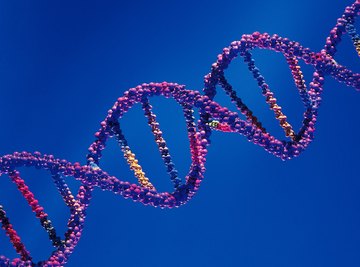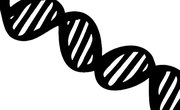
Polymerase chain reaction, or PCR, is a technique that photocopies one fragment of DNA into many fragments -- exponentially many. The first step is in PCR is to heat the DNA so that it denatures, or melts into single strands. The structure of DNA is like a rope ladder in which the rungs are ropes with magnetic ends. The magnets connect to form the rungs, called base pairs, and thus resist being pulled apart. Each fragment of DNA melts into single strands at different temperatures. Understanding how the structure of DNA is held together by DNA’s individual parts will give insight into why different DNA fragments melt at different temperatures and why such high temperatures are needed in the first place.
Melting! Melting!
The first step of PCR is to melt the DNA so that double-stranded DNA separates into single-stranded DNA. For mammalian DNA, this first step usually involves heat of approximately 95 degrees Celcius (about 200 Fahrenheit). At this temperature the hydrogen bonds between the A-T and G-C base pairs, or rungs in the DNA ladder, break apart, unzipping the double-stranded DNA. However, the temperature is not hot enough to break the phosphate-sugar backbone that forms the single strands, or the poles of the ladder. Complete separation of single strands prepares them for the second step of PCR, which is cooling to allow short DNA fragments, called primers, to bind the single strands.
Magnetic Zippers
One reason DNA is heated to the high temperature of 95 degrees Celcius is that the longer the DNA double strand is, the more it wants to stay together. DNA length is one factor that affects the melting point chosen for PCR on that piece of DNA. The A-T and G-C base pairs in the double-stranded DNA bond with each other to hold the double-strand structure together. The more consecutive base pairs between two single-strands have bonded, the more their neighbors also want to bond, and the stronger the attraction between the two strands becomes. It is like a zipper made of small magnets. As you close the zipper, the magnets will naturally want to zip up and stay zipped.
Stronger Magnets Stick More Tightly
Another factor that affects which melting temperature to choose for your DNA fragment of interest is the amount of G-C base pairs present in that fragment. Each base pair is like two mini-magnets that attract. A pair made of G and C is much more strongly attracted than an A and T pair. Thus a piece of DNA that has more G-C pairs than another fragment will require a higher temperature before melting into single strands. DNA naturally absorbs ultraviolet light -- at the 260 nanometer wavelength, to be exact -- and single-stranded DNA absorbs more light than does double-stranded DNA. So measuring the amount of light absorbed is a way of measuring how much your double-stranded DNA has melted into single strands. The "magnetic zipper" effect of G-C and A-T base pairs is what causes a graph of the light absorbance of double-stranded DNA plotted against an increase in temperature to be sigmoidal, shaped like an S, and not a straight line. The curve of the S represents the teamwork resistance that the base pairs exert against the heat because they don’t want to separate.
The Halfway Point
The temperature at which a length of DNA melts into single strands is called its melting temperature, which is denoted by the abbreviation “Tm.” This indicates the temperature at which half the DNA in a solution has melted into single strands and the other half is still in double-strand form. The melting temperature is different for each fragment of DNA. Mammalian DNA has a G-C content of 40%, meaning the remaining 60% of the base pairs are As and Ts. Its 40% G-C content causes mammalian DNA to melts at 87 degrees Celcius (about 189 Fahrenheit). This is why the first step of PCR on mammalian DNA is to heat it to 94 degrees Celcius (201 Fahrenheit). Just seven degrees hotter than the melting temperature and all double strands will completely melt to single strands.
References
About the Author
David H. Nguyen holds a PhD and is a cancer biologist and science writer. His specialty is tumor biology. He also has a strong interest in the deep intersections between social injustice and cancer health disparities, which particularly affect ethnic minorities and enslaved peoples. He is author of the Kindle eBook "Tips of Surviving Graduate & Professional School."
Photo Credits
Comstock/Stockbyte/Getty Images
